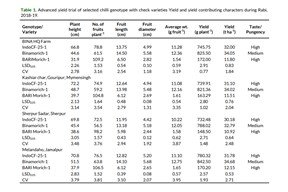Binamorich-2: A new high yielding Chilli variety of Bangladesh
Abstract
Chilli is one of the most important spices as well as cash crop in Bangladesh. This study was undertaken at Bangladesh Institute of Nuclear Agriculture (BINA) to characterize the collected germplasm morphologically and select a desirable one for commercial cultivation in Bangladesh. More than fifty chilli germplasm were collected from local and exotic sources were put into evaluation to select desirable ones for directly use as varieties or for future usage as breeding materials. Through observation trials five germplasm were selected considering their better agronomic performance. Selected germplasm was evaluated through different trials at different chilli growing areas of Bangladesh during 2018 to 2020. Recommended cultural management for chilli cultivation was followed. The germplasm, IndoCF-25 produced significantly higher yield both green chilli and dried chilli than control varieties (Binamorich-1 and BARI Morich-1) in most of the trials. Over two years of advanced yield trial and on-farm trial, IndoCF-25 produced higher yield (32.00 t ha-1) while BARImorich-1 produced (12.15 t ha-1). IndoCF-25 was produced the longest plant height (78.8 cm), higher number of fruits (78.8) compared to Binamorich-1 (52.8), longer fruit size (13.95 cm), breadth (5.32 cm) and single fruit weight (11.38 g) compared to the check varieties. IndoCF-25 was found to be moderately tolerant to anthracnose, wilting and mosaic diseases, and also showed lower insect infestation than control varieties. Results of yield trials indicated that IndoCF-25-1 was suitable for cultivation in Bangladesh. Though check variety Binamorich-1 produced the highest yield (34.05 t ha-1) among three tested genotype/varieties, due to the better pungency as well as other quantitative and qualitative performances, BINA has applied for registration of IndoCF-25-1 to the National Seed Board (NSB) of Bangladesh. Consequently, the NSB of Bangladesh registered IndoCF-25-1 as a high yielding better pungent chilli variety in 2020 as Binamorich-2 for commercial cultivation all over Bangladesh.
Keywords:
Binamorich-2, Chilli germplasm, High yielding, Selection, VarietyDownloads
References
Akinfosoye, J. A., Olufolaji, A. O., Tairu, F. M., & Adenowoola, R. A. (1997). Effect of Different phosphosrus levels on the yield of four varieties of rainfed tomato (Lycopersicon esculentum). Proceedings of the Hortson, 15 (1), 65-66.
BBS (Bangladesh Bureau of Statistics), 2018. Year Book of Agricultural Statistics of Bangladesh. Bangladesh Bureau of Statistics, Ministry of Planning, GOB. Dhaka, Bangladesh, pp: 48.
El-Ghoraba, A. H., Javedb, Q., Anjumb, F. M., Hamedc, S. F., & Shaabana, H. A. (2013). Pakistani Bell Pepper (Capsicum annum L.): Chemical Compositions and its Antioxidant Activity. International Journal of Food Properties, 16(1),18-32
Gomez, K. A. and Gomez, A. A. (1984). Statistical Procedures for Agricultural Research. John Wiley and Sons, USA.
Hill, T. A., Ashrafi, H., Reyes-Chin-Wo, Yao S. J., Stoffel, Truco, K. M. J., & Vaneynze, A. (2013). Characterization of Capsicum annuum genetic diversity and population structure based on parallel polymorphism discovery with a 30K unigene Pepper Gene Chip. PLoS One, 8(2), e56200.
Ibiza, V. P., Blanca, J., Cañizares, J., & Nuez. F. (2012). Taxonomy and genetic diversity of domesticated Capsicum species in the Andean region. Genetic Resources and Crop Evolution, 59(6), 1077-1088.
Obidiebube, E. A., Eruotor, P. G., Akparobi, S. O., Emosaariue, S. O., Achebe, U. A., & Kator, P. E. (2012). Response of four cultivars of pepper (Capsicum frutescens L.) to different levels of NPK fertilizer in rainforest agroecological zone. International Journal of Agri Science, 2(12), 1143-1150.
Odeleye, F. O., & Odeleye, O. M. O. (2001). Evaluation of morphological and agronomic characteristics of two exotic and two adapted varieties of tomato (Lypersicon esculentum) in south West Nigeria. Proceedings of the Annual conference of Hortson, 19(1), 142-145.
Rajput, J. C., Palwe, S. B., & Patil, P. B. (1991). Varietal evaluation of red chillies for, yield and quality in Konkan region of Maharastra. Indian Cocoa, Arecanut Spices Journal, 14, 107-108.
Singh, B. D. 2009. Plant Breeding, Principles and Methods. Kalyani Publishers, New Delhi, India, pp. 667.
Soeranto, H. (2011). Plant breeding with mutation technique (in Indonesian). Indonesian Center for Isotopes and Radiation Technology Research and Development. Jakarta: National Nuclear Energy Agency of Indonesia.
Thul, S. T., Lal, R. K. Shasany, A. K. Darokar, M. P., Gupta, A. K., Gupta, M. M., Verma R. K. and Khanuja, S. P. S. (2009). Estimation of phenotypic divergence in a collection of Capsicum species for yield related traits. Euphytica, 168 (2), 189-196.
Uddin, A. J., Hussain, M. S., Rahman, S. S., Ahmad, H., & Roni, M. Z. K. (2015). Growth, yield and quality of SAU-Agni and SAU- SAU Cayenne chilli variety. Bangladesh Residues Publication Journal, 11(3), 198-203.

Published
How to Cite
Issue
Section
Copyright (c) 2021 Agriculture and Environmental Science Academy

This work is licensed under a Creative Commons Attribution-NonCommercial 4.0 International License.

